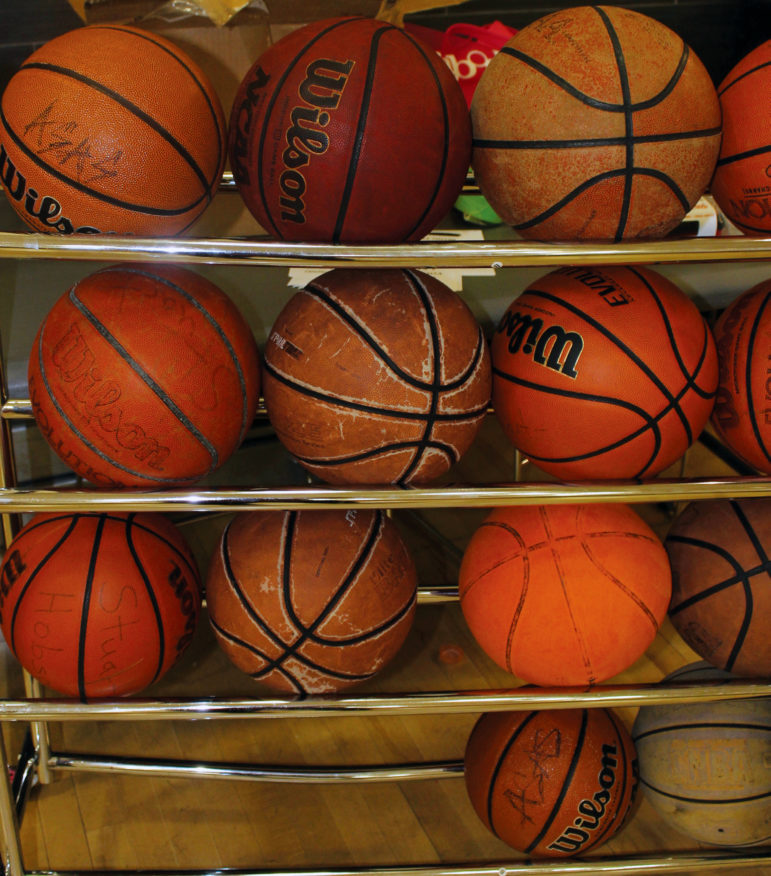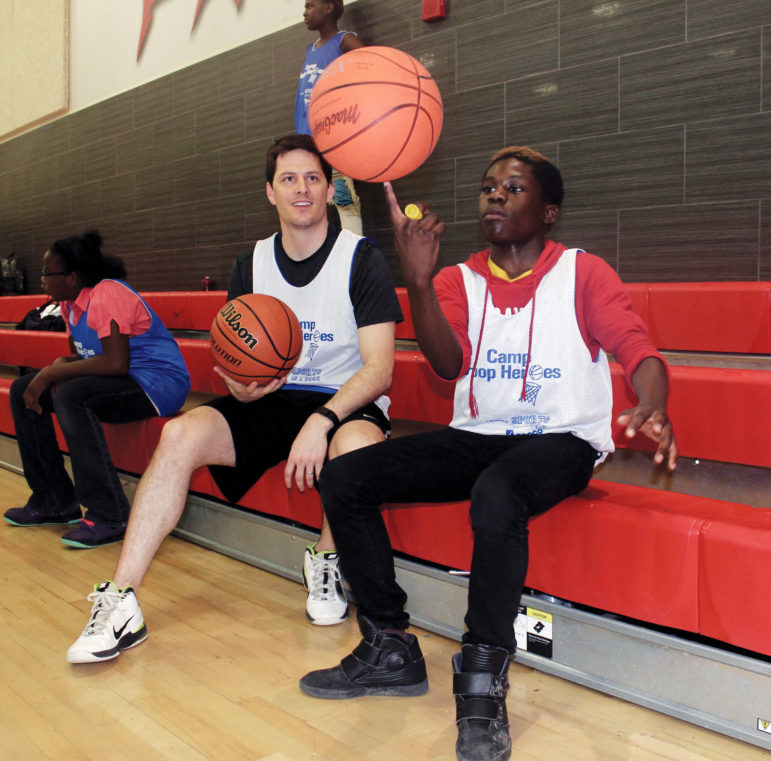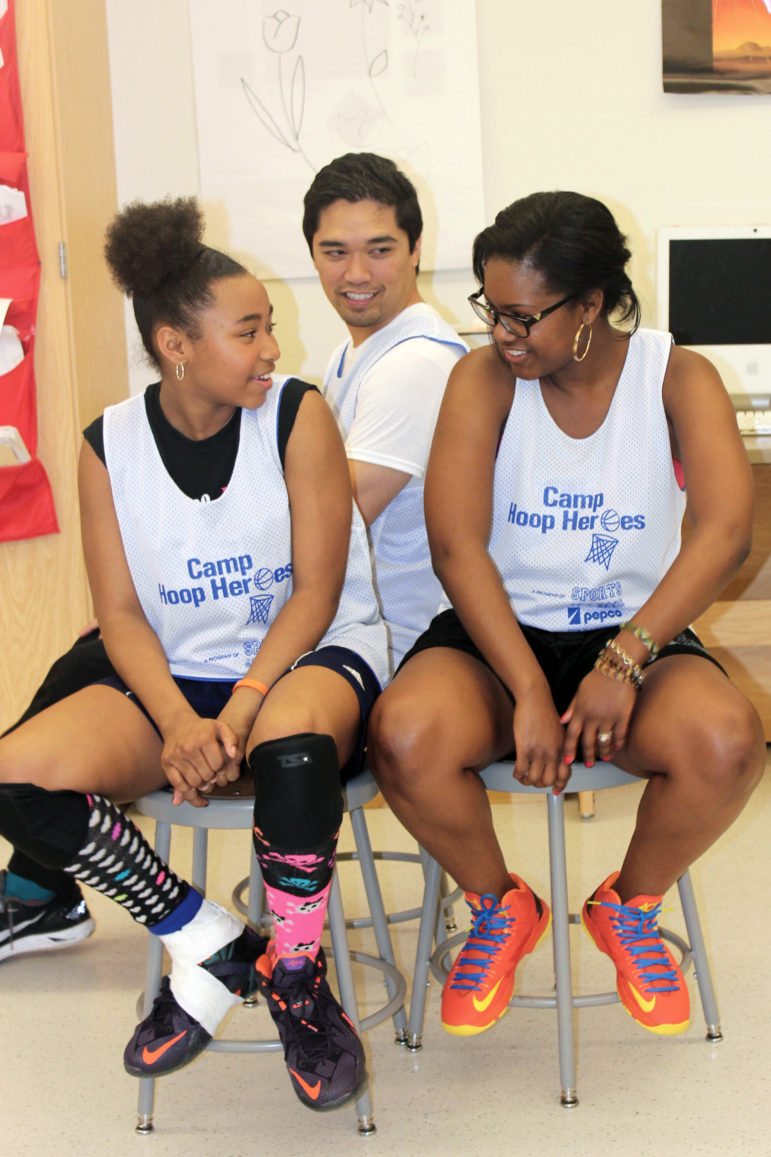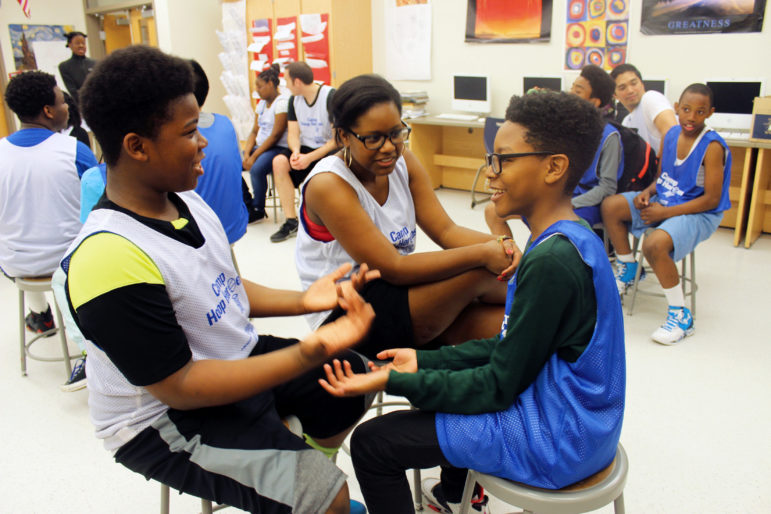
Photos by Sarah Barr
.
Programs that know why middle school matters attract participants, funding amid rising demand
Last year, when Allysha Bryant went to Camp Hoop Heros for the first time, one of her mentors complimented her as on how hard she had worked during basketball drills.
“If you keep up that hard work, you can do lots of good things in your life,” he told her.
Since then, Bryant, 13, has hung on to that advice. She thinks about it when she strives for good grades in school, the kind she hopes will set her on a path to forming her own dance company someday.
Bryant knows her mentors at camp made a difference for her. Millions of other students don’t get the chance to participate in afterschool programs though, because programming fails to engage them or there is not enough funding to meet demand.
But programs that recognize the potential of tween and teens, including how their brain development makes them unique, are well positioned to attract both participants and funders, say experts.
At the weekly camp, run by After-School All-Stars, mentors and students team up to listen to guest speakers, talk about skills such as confidence, resilience and fairness, and practice their basketball moves side-by-side.

The fact that students can keep up with their mentors both physically and intellectually, in conversations like the one between Allysha and her mentor, is one of the joys of working with tweens and teenagers, said Aaron Philip Dworkin, president of the National Network for After-School All-Stars, an out-of-school time program with 16 locations around the country.
The students are primed for learning about what it takes to succeed in high school, college and beyond, whether it’s healthy eating habits or study habits.
“You can have those conversations. It’s a little more real,” Dworkin said. “You can talk to second graders about college all day, but it’s so far away.”
Participation drops, demand is up
Across the country, participation in after-school programs drops as children age. In 2014, 10.2 million children were in an after-school program, or 18 percent of children in kindergarten through 12th grade, according to a report by the Afterschool Alliance.
But, while 23 percent of elementary-school children enrolled in a program, the rate dropped to 19 percent of middle-schoolers and 12 percent of high-school students, according to the same data.
Families and communities are likely to consider after-school programs paramount for younger children as a vital form of child care for working parents, said Jodi Grant, executive director of the Afterschool Alliance.
[Related: Taking a Systemic Approach to Access and Equity in Afterschool]
In addition, families are more willing to pay whatever they must to keep a 6-year old supervised, but that changes for a 13-year-old. Some families may decide they cannot afford an after-school program for older children. Communities with limited resources face a similar question when deciding which programs to fund, said Grant.

Grant said that points to the need for additional federal funding, as well as other sources of funding, to make sure youth of all ages can access programs instead of having to prioritize one group over the other.
“We’re in this unfair choice where you have limited resources,” she said. “It’s hard to cut 7-year olds to serve 12-year olds.”
When it comes to encouraging participation, tweens and teens also can be tougher to engage than younger students. They have more say in how they spend their time and want exciting, challenging programs, say program leaders.
Even though tweens and teens are less likely than younger kids to participate in after-school programs, their numbers are growing. In 2009, 1.4 million middle-school students were part of an after-school program. By 2014, that number had grown to 2.3 million, according to the same study by the Alliance.
Alongside those increases, demand for middle-school programs is up. In 2014, 4 million middle-school students not currently enrolled in an afterschool program would participate if one were available, up from 3.1 million in 2009, according to the study.
They vote with their feet
The increases in participation and demand seem to stem from two things: the needs of working parents and increasingly savvy, sophisticated middle-school programming, said Nikki Yamashiro, director of research at the Afterschool Alliance.
After years of struggling to find a nice, middle school programming has found a way to be cool, with robotics, music recording labs, sports and poetry slams — just a few of the programs students can choose from.
“There are a lot more enriching activities that are academic but also fun,” Yamashiro said.
Programs that draw middle schoolers recognize that students want to help shape offerings. Tweens and teens have ideas about what is important to them and what they want to discover.
Program leaders should know that crafting those experiences can be costly — and should budget accordingly, said Saskia Traill, vice president of policy and research at ExpandED Schools, formerly known as TASC.
She recalled the story of one group of students who wanted to take a hip-hop class from someone with real expertise. The program leaders were able to find a performer and pair his experience with that of a youth development expert.
It was more expensive — but it kept the students coming back, at an age when they’re not required to stay until someone picks them up.
“They do vote with their feet. If it’s not authentic and meaningful and they don’t feel that connection, they’ll leave,” she said.

Attendance is case for funding
When students do attend programs regularly, program leaders may have greater luck securing state and federal funding with strict attendance requirements, which have historically focused on younger children, said experts.
Traill said other promising sources of income could come from private funders with an interest in social-emotional learning, and who see middle-school as a ripe time to focus on those skills.
In addition, she urged programs leaders to pay attention to 21st Century Community Learning Center grants, the only dedicated federal source of after-school funding. They should stress the importance of middle- and high-school programs as states adjust to the new federal Every Student Succeeds Act.
“If you’re not part of the conversation, it may drift away from the current priorities,” Traill said.
Lynsey Wood Jeffries, CEO of Higher Achievement, a year-round academic training program, said foundations often focus on early childhood or college access, potentially leaving middle-school programs in the lurch.
But there are ways to show how vital middle school is, Jeffries said. She highlights for donors how rapidly the brain is developing during adolescence, making it a prime time to direct tweens and teenagers down the right path.
“It’s really important to intervene during this transition period. I try to take what people have heard and understood about early childhood and apply it to middle school,” she said.
Dworkin, too, said he stresses to donors the value of influencing tweens and teens.
“Kids make or break their habits for life in those middle school years,” he said.
Both Higher Achievement and After-School All-Stars have received grants from the New York Life Foundation, one major private backer of out-of-school time programs for middle-school students.
There, the message that supporting kids in middle school positions them for the best outcomes in high school and beyond has gotten through loud and clear, said Heather Nesle, president of the foundation. Since 2013, the group has awarded $23 million in grants for out-of-school time programming.
Nesle said the foundation sees the demand for more middle school programs as evidence they’ve zeroed in on an important area.
“We’ve been validated that this is a really important space to play,” she said.
Resources:
The Afterschool Alliance offers tips on writing proposals and identifying donors at afterschoolalliance.org/fundingTools.cfm
ExpandED Schools has a video that highlights why the middle school years are such a critical time for brain development, online at expandedschools.org/blog/use-it-or-lose-it-adolescent-brain#sthash.gxY4rF72.dpbs
Information on federal funding for after-school programs is available at youth.gov/youth-topics/afterschool-programs/funding-afterschool
The Baltimore-based After-School Institute publishes a page about OST funders at afterschoolinstitute.org/tasi/getfunding/default.aspx
More related articles:
In Rural America, High Poverty, High Need for After-school Programs
After School Is ‘Sweet Spot’ to Draw Girls to STEM
Leading After-school Group Disappointed by Obama Budget
































